iPad 4 (Late 2012) Review
by Anand Lal Shimpi on December 6, 2012 4:40 PM ESTDisplay Analysis
The 4th gen iPad retains the same Retina Display as its predecessor. The 9.7-inch 2048 x 1536 display looks just as good as it did earlier this year. Brightness, black levels and contrast are all very good. The real advantage however is color accuracy thanks to Apple's factory calibration on all of its devices with an integrated display.
As with all of Apple's other Retina Displays, software support is made easy through integer scaling. The 2048 x 1536 resolution is an increase of 2x in both dimensions over the standard iPad/iPad mini resolution. App developers simply have to provide 2x scaled assets in order to make the most of the Retina Display. Deciding what image to load (standard res or 2x scaled) is handled automatically, the developer just needs to ensure that it's supplying both sets of images for the best user experience. Games can run either at the panel's native resolution, or run at a non-native offscreen resolution and simply scale up to the panel resolution if the title's performance requirements are too high (more on this later).
All first party apps and most of the 3rd party iPad apps I use on a regular basis are already Retina aware.
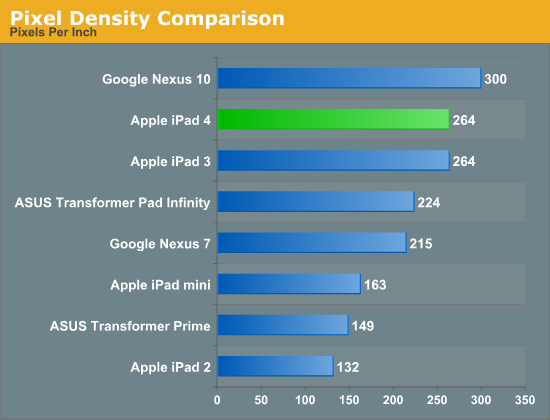
The big advantage the Retina Display offers over other iPads is a much better text reading experience. Individual letters look so much smoother:

I borrowed the paragraph shots below from our iPad mini review to give a better idea of how much of an improvement the Retina Display delivers when reading text:
Images also benefit from the Retina panel, but the advantage here ends up mostly being the accuracy of the display rather than the pixel density.

iPad mini (left) vs. iPad 4 (right)
With the exception of the 3rd generation iPad, only the Nexus 10 boasts any real competition to the iPad 4's display. I don't have a Nexus 10 on hand but Brian ran our suite of display tests on his review unit. Let's see how the two stack up in basic brightness and contrast measurements:
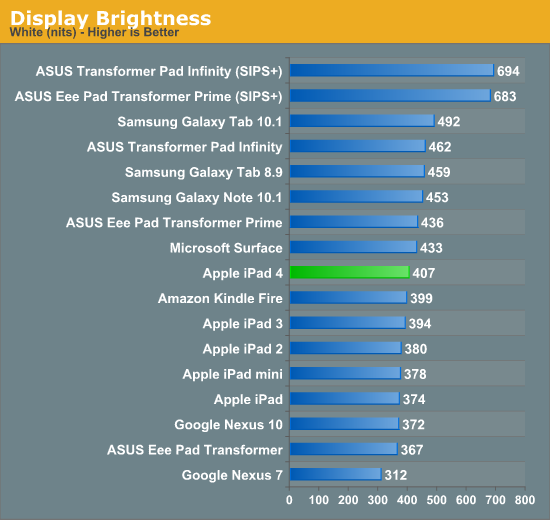
It's amazing to me that 400 nits on a nearly 10-inch display is simply middle of the pack now in modern tablets. This is just awesome. Look at any of our value notebook reviews and you'll find a bunch of displays that typically max out at sub 300 nits. It's no wonder that tablet sales are doing very well among consumers.
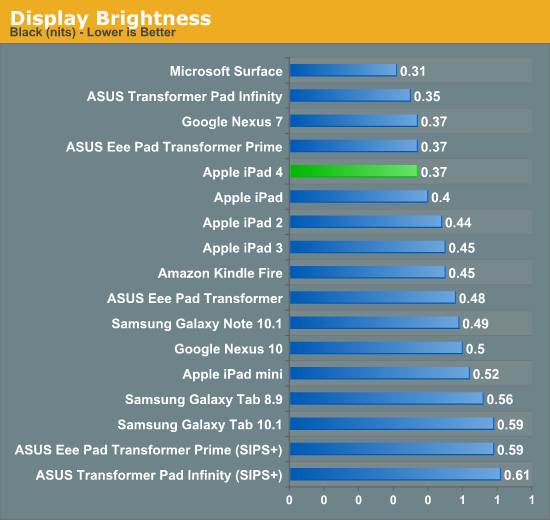
Black levels are good on the 4th generation iPad. Microsoft still holds the clear lead in black levels with its Surface RT, thanks to the tablet's bonded coverglass and display stack.
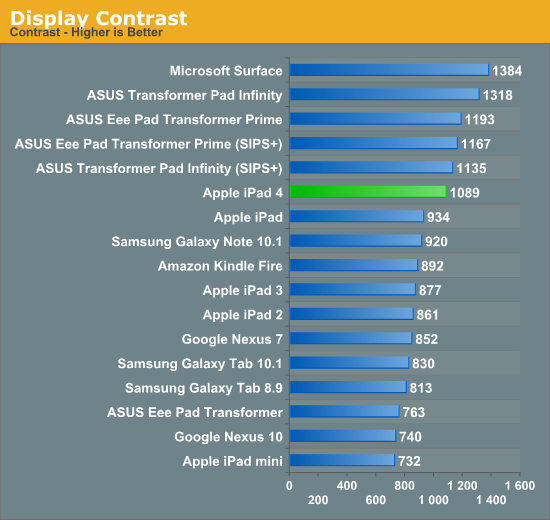
Overall contrast ratio is very good on the iPad 4. I measured a significant improvement over my iPad 3, although I suspect that has to do more with improvements to panel manufacturing than anything more deliberate.
Maintaining good brightness while pushing pixel density is only part of the equation. What made the iPad 3's display so great was that it shipped well calibrated from the factory. I assumed the same would be true for the 4th generation iPad, but I still needed to test to confirm.
To evaluate color accuracy I turned to our own Chris Heinonen's CalMAN smartphone/tablet workflow. We'll start off by looking at the calibrated white point for these tablets. What you're looking for here is a number close to 6500K:
Apple has been drifting north of 6503K for a while now. Variation in white point does seem to track well with individual panel makers in the iPad, so you may see numbers move around here depending on your luck of the draw. We've seen this in other iDevices in the past where whites will range from yellow to blue depending on what panel you end up with.
The next three charts look at accuracy represented as a difference between various source colors and what's reproduced on the display. The results are presented as average dE2000, with lower numbers being better.
First up is Grayscale performance, here we're looking at the accuracy of black, white and 19 shades of gray spread in between the two extremes:
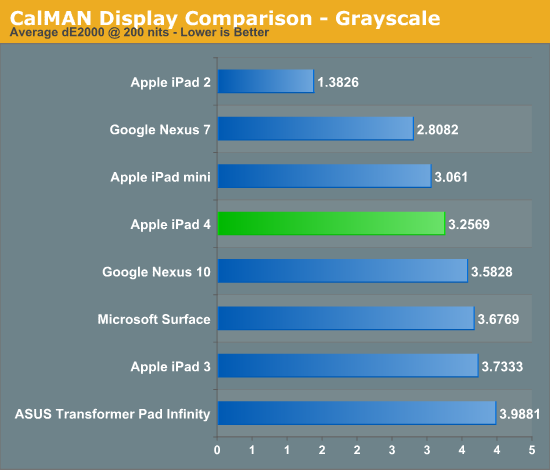
The 4th gen iPad does pretty well here, just edging out the Nexus 10 but losing to the iPad 2 and mini. Pretty much all of the tablets do a good job here at accurately reproducing grays.
First in our color accuracy tests is a saturation sweep. Here we're looking at 20%, 40%, 60%, 80% and 100% saturations of red, blue, green, magenta, yellow and cyan.
This is what you get with the iPad's pre-calibrated Retina Display: appreciably better color accuracy than any other tablet on the market today. I even measured an improvement in color accuracy compared to last year's iPad 3, however my iPad 3 was from the initial runs of production. I have noticed pretty significant variance between color accuracy between iPads. The results are always good, but some are definitely better than others.
Gamut CIE Chart
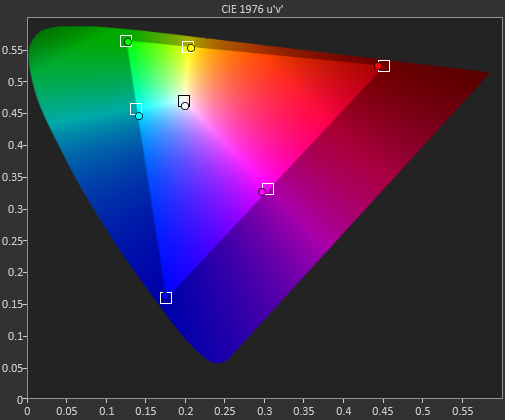
Saturation CIE Chart
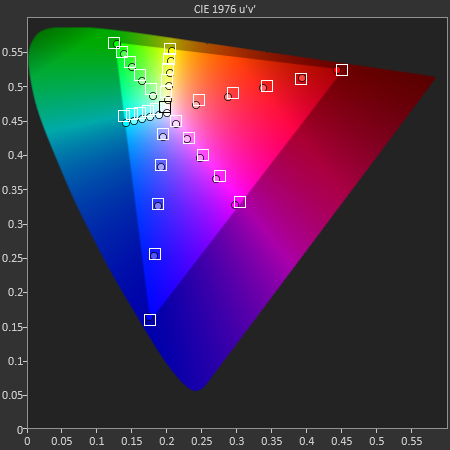
For our final accuracy test we're looking at the difference between a Gretag Macbeth colorchecker chart and the rendered swatches on these displays. Once again, lower numbers are better.
Many of the panels used here are actually good panels, the difference really boils down to calibration. Apple continues to dominate in terms of calibrated color accuracy. The 4th gen iPad's display remains the best in the industry from a color accuracy standpoint.
GMB Color Checker
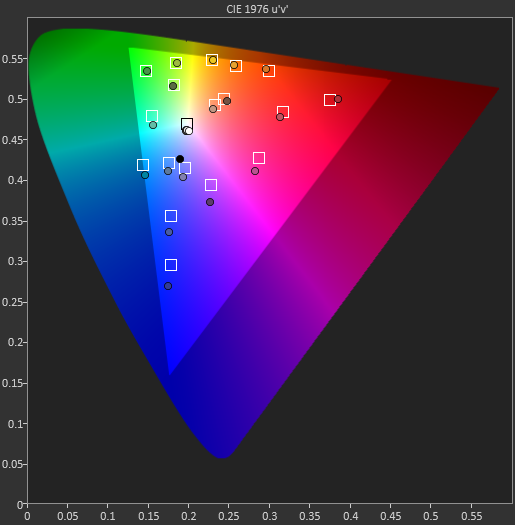



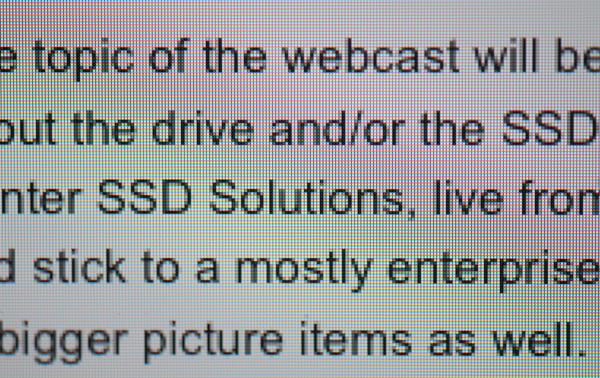
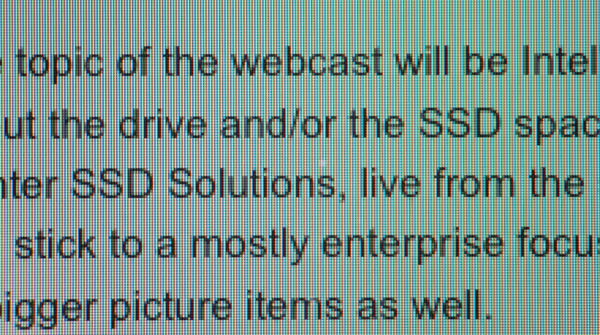
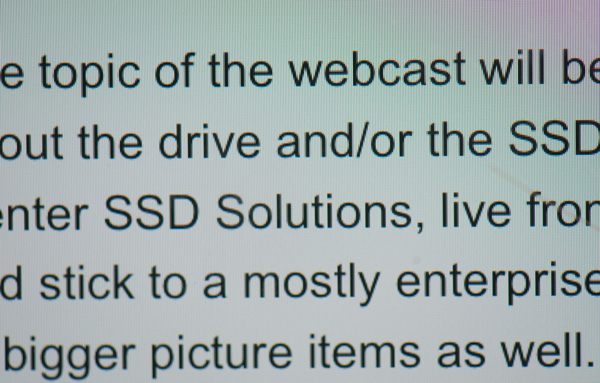
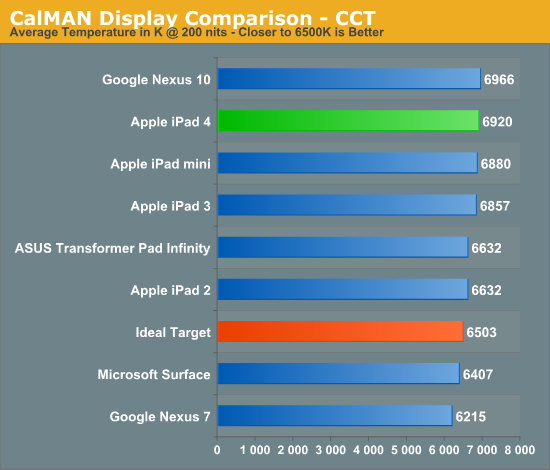
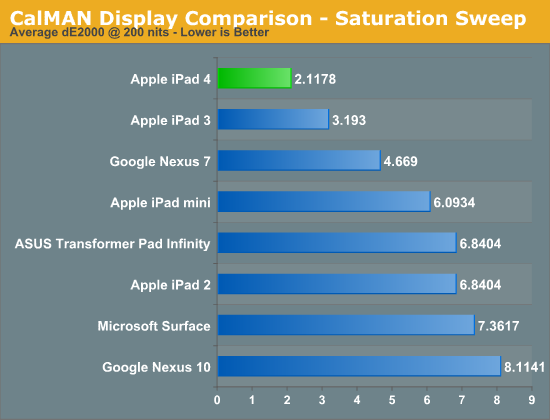
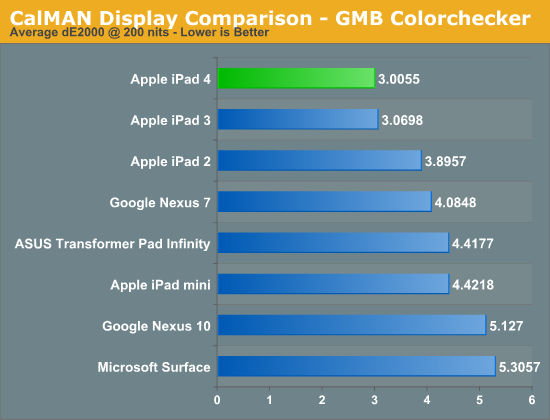








113 Comments
View All Comments
darkcrayon - Friday, December 7, 2012 - link
"Can you run full OS VMs in iOS? "Well iOS is perfectly capable of running emulators if that's what you mean. I start up Windows 3.1 on mine every once in a while for a laugh ;)
If you mean run at some metal-level virtualization then no, but then that wouldn't really be running on Android so much as on the hardware of the device.
antef - Friday, December 7, 2012 - link
If you think Android is just as appliance-like as iOS then I feel there are major things about the platform that you are uninformed about. Not saying that in a demeaning way, just saying perhaps you never discovered these aspects of the system.iOS cannot be considered a true "computing platform" when you can only get apps via the App Store, they can only do what Apple approves of, and they can't truly run in the background, instead being able to only do certain things when not in the foreground. It's a large set of restrictions limiting what can be done with the device, thus it's an appliance, regardless of what functionality apps may or may not provide. It's no different from a set-top box or any other CE device, except it offers way more apps.
Android, on the other hand, even without rooting or messing with custom ROMs, lets you install any app, from any source, that does anything the developer wishes it to do. You don't have to use any app store or pay Google any fees if you don't want to. Apps can touch almost any part of the system or replace any part of the system. Apps can do absolutely anything in the background with almost no restriction. You can browse and manage files like on a PC. The list goes on and on.
Same thing regarding customization. Without rooting Android, you can change its keyboard, default browser, default mail handler, and the entirely of its home screen (icons, dock, app drawer, all can be replaced with alternate launcher).
Android has very few restrictions above and beyond what a typical desktop platform like Windows has. It's essentially Linux with a special app container format and custom UI, that ships without su by default. Yeah, maybe the typical user just using web, texting, and Facebook will think both platforms are equally appliance-like, but that doesn't change the fact of what Android can do. I believe Anand's analysis is spot on.
darkcrayon - Friday, December 7, 2012 - link
It seems Android can only do "certain things" in the background as well. Or maybe you can tell me how to play youtube audio from the browser while Chrome is suspended (You can do this in Safari on iOS).iOS is a true computing platform - it's your definition of "computing" that is the problem. You *can* enter code and run software on it that did not originate on the App Store (not that if you couldn't, it would somehow cease to be a "computing platform".)
It's certainly easier to do more "mucking around" with Android - iOS just has a more security oriented approach while Android has more versatility. Of course for 99% of users for either platform, none of that matters in the slightest as they buy the device to browse the web, play media, and find useful software to run.
Velius - Monday, December 10, 2012 - link
First, I have to thank everyone who responded to my original post. I was shaking my head afterward submitting my post since the way it was originally written was definitely flamebait. Kudos for being respectful and *helpful* in your responses, when I most certainly deserved an ass-kicking.These are all good points (especially antef with respect to my original points) and well expressed. You are right, there are more things that can be customized in Android, but I think you can do it in iOS too - just have to jailbreak it first. The difference, IMO, is that with Android, you *have* to replace most of the defaults because the defaults are really not good. When I used my SGS3, the default keyboard was horrendously slow. SwiftKey 3 rectified that to a large extent, but was a paid app. Why should I have to pay to have a usable keyboard?
Same with the music player - I disagree, first of all, that Poweramp is better than the iOS music player. I found Poweramp to be underwhelming, with player buttons and icons that look like really badly designed bitmaps. Along these lines, any music player on Android lacks the fine-grained seek capabilities that iOS has (which is called "scrubbing" there). I really missed the ability to seek with greater or lesser granularity, going down to the second. You can't do that in Android - the seeks are all giant leaps. Similar story with volume control. There are only 15 settings on the SGS3 (and I assume Android in general). Most of the time, the music I would listen to would be ideally loud between, say, 12 and 13, but I could never set it to that. If I set the volume to 12, it would be too soft, and if I set it to 13, too loud. In iOS, there is very fine control over volume. And let's not even get to transitions between tracks. There is always a gap in the default SGS3 music player between tracks - this would perhaps have been understandable in 1995, but is completely unacceptable today!
These little things add up substantially - the list goes on and on - making iOS just more polished. Even the basic OS responsiveness is a deal-breaker. On my SGS3, if I reboot the phone and go to type something up, say in a text message, it takes about 10 seconds before it even registers my keyboard presses. This is mind-boggling, and I truly wonder how many people on online forums say Android is "faster" - it is not, at least definitely not with the OS interface. I really do believe that people who claim Android is faster just haven't used iOS. Once you do, you just can't go back. :3
Getting back to the original topic, I also don't fully agree that iOS is an appliance. The reason Apple vets software before allowing it to go on the App Store is mostly for quality control. Just search Google for "android apps insecure", and read pages with titles like, "Research says Android users at high risk of installing insecure apps", "Researchers find 1,000 insecure Android apps", and "One in five Android apps is insecure". Yes, you can sideload apps onto your Android phone, but it's a double-edged sword: the Android software ecosystem is a true wild west, with all the attendant issues: buggy or plain crappy software, crashes, malware, insecure apps, etc. I'm not saying Apple's App Store is immune to this, but it's definitely far less prone to it.
In all, I stand by my original claim: "iOS is an appliance, Android is a true computing experience" is a completely bogus and harmful meme. Why harmful? Because millions of people are buying Android phones in the belief that it's better than iOS, when it just isn't. They are thus robbing themselves of a truly polished, wonderfully designed mobile hardware+software computing platform (iOS on iPhone) that is still the top in its class.
Peace.
Velius - Monday, December 10, 2012 - link
Just to clarify, the point I made about Android's responsiveness - and examples I gave from my experience - were all based on Jelly Bean 4.1 stock ROM from Samsung. The "project butter" benefits were only really seen when scrolling between pages (and even then, it got choppy as the SGS3 was loading some widgets). Otherwise, when you open a browser or basically any app, and try to scroll, it is noticeably less smooth. It's like it only scrolls in jumps of 20 pixels at a time. Reducing animation times and forcing GPU rendering in the options alleviated this somewhat, but not entirely.Again, it boggles the mind how such a powerful device (from the hardware standpoint) can be so slow in its user interface - arguably the most important factor in usability!
DeciusStrabo - Friday, December 7, 2012 - link
for its power, the App selection, the looks, the lightning connector (yes, except the price it's really a great connector), Airplay etc.However, I don't like it nearly as much holding it in my hands than my Nexus 10. It's cold, slippery, heavy. You can't really hold it in one hand easily and if you use your body to prop it up if you lie on your couch the edge tends to get really uncomfortable (less than with the iPad 2 but still far too much). As nice as the aluminium looks I prefer the cheaper looking coated plastic of the Nexus 10. Also, speakers on the front > speakers on the back, usually where you tend to hold the thing, even if the one on the iPad is better than the two on the Nexus soundwise.
maximumGPU - Friday, December 7, 2012 - link
what's more concerning is how exactly do you have use for 2 same sized tablets?!eallan - Friday, December 7, 2012 - link
Sometimes we like to waste money on toys!seapeople - Friday, December 7, 2012 - link
2 people = use for 2 tablets? Perhaps the guy is married? Otherwise, I agree, he's insane. It would be like the most colossal waste of money on the planet to buy multiple tablets within a five year period. I mean, that's like half a thousand dollars... for each! Only a very select few fat cats in our society make thousands of dollars that they can just spend on stuff.mavere - Saturday, December 8, 2012 - link
I honestly can't decide whether the latter half of your post is sarcasm.